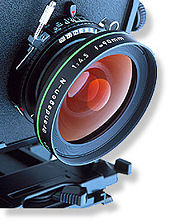Title.

Photography is the result of combining several technical discoveries. Long before the first photographs were made, Ibn al-Haytham (Alhazen) (965–1040) invented the camera obscura and pinhole camera,[2] Albertus Magnus (1193–1280) discovered silver nitrate, and Georges Fabricius (1516–1571) discovered silver chloride. Daniel Barbaro described a diaphragm in 1568. Wilhelm Homberg described how light darkened some chemicals (photochemical effect) in 1694. The fiction book Giphantie, by French author Tiphaigne de la Roche, described what can be interpreted as photography.
Photography as a usable process goes back to the 1820s with the development of chemical photography. The first permanent photograph was an image produced in 1826 by the French inventor Nicéphore Niépce. However, the picture took eight hours to expose, so he went about trying to find a new process. Working in conjunction with Louis Daguerre, they experimented with silver compounds based on a Johann Heinrich Schultz discovery in 1724 that a silver and chalk mixture darkens when exposed to light. Niépce died in 1833, but Daguerre continued the work, eventually culminating with the development of the daguerreotype in 1837. Eventually, France agreed to pay Daguerre a pension for his formula, in exchange for his promise to announce his discovery to the world as the gift of France, which he did in 1839.
Meanwhile, Hercules Florence had already created a very similar process in 1832, naming it Photographie, and William Fox Talbot had earlier discovered another means to fix a silver process image but had kept it secret. After reading about Daguerre's invention, Talbot refined his process so that it might be fast enough to take photographs of people. By 1840, Talbot had invented the calotype process, which creates negative images. John Herschel made many contributions to the new methods. He invented the cyanotype process, now familiar as the "blueprint". He was the first to use the terms "photography", "negative" and "positive". He discovered sodium thiosulphate solution to be a solvent of silver halides in 1819, and informed Talbot and Daguerre of his discovery in 1839 that it could be used to "fix" pictures and make them permanent. He made the first glass negative in late 1839.
In March 1851, Frederick Scott Archer published his findings in "The Chemist" on the wet plate collodion process. This became the most widely used process between 1852 and the late 1880s when the dry plate was introduced. There are three subsets to the Collodion process; the Ambrotype (positive image on glass), the Ferrotype or Tintype (positive image on metal) and the negative which was printed on Albumen or Salt paper.
Many advances in photographic glass plates and printing were made in through the nineteenth century. In 1884, George Eastman developed the technology of film to replace photographic plates, leading to the technology used by film cameras today.
In 1908 Gabriel Lippmann won the Nobel Laureate in Physics for his method of reproducing colours photographically based on the phenomenon of interference, also known as the Lippmann plate.
